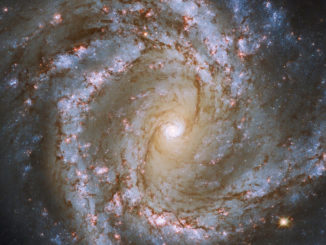
New studies using NASA’s Chandra X-Ray Observatory, the Hubble Space Telescope and other observatories indicate that supermassive black holes are growing much faster than the rate of star formation in the massive galaxies that host them.
Earlier observations led astronomers to believe the rates of galactic star formation and the growth of supermassive black holes, those with millions to billions of times the mass of the Sun, marched in tandem.
But data from Chandra, Hubble and other telescopes shows the black holes lurking at the hearts of massive galaxies are growing much faster than those in less massive star swarms. In fact, the ratio between a supermassive black hole’s growth and the growth rate of stars in the host galaxy is 10 roughly times higher in galaxies with 100 billion solar masses compared to galaxies with about 10 billion solar masses.
“We are trying to reconstruct a race that started billions of years ago,” Guang Yang, a researcher at Pennsylvania State University who led one of two studies on black hole growth rates, said in a Chandra release. “We are using extraordinary data taken from different telescopes to figure out how this cosmic competition unfolded.”
Said co-author Niel Brandt, also of Penn State: “An obvious question is why? Maybe massive galaxies are more effective at feeding cold gas to their central supermassive black holes than less massive ones.”
Yang, Brandt and their colleagues studied black hole in galaxies at distance of 4.3 to 12.2 billion light years. A second group of researchers independently reached the same conclusion studying 72 galaxies in clusters up to about 3.5 billion light years from Earth using an established relationship between the mass of a black hole and its X-ray and radio emissions
“We found black holes that are far bigger than we expected,” said Mar Mezcua, of the Institut of Space Sciences in Spain. “Maybe they got a head start in this race to grow, or maybe they’ve had an edge in speed of growth that’s lasted billions of years.”
Almost half of the black holes in their sample were estimated to be at least 10 billion times the mass of the Sun, placing them in the “ultramassive” weight class.



